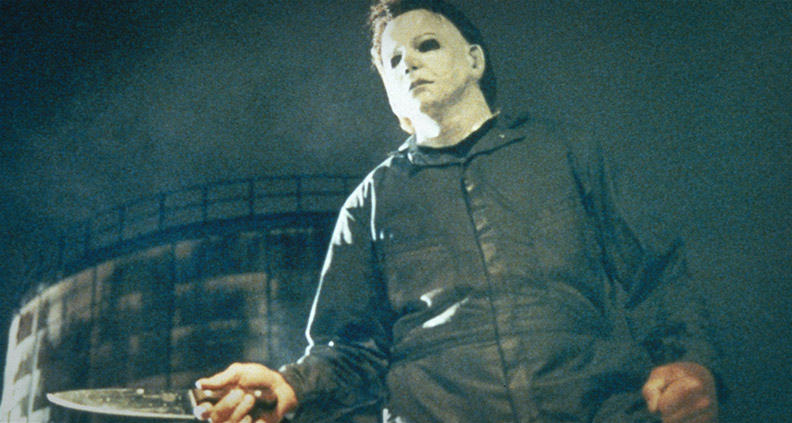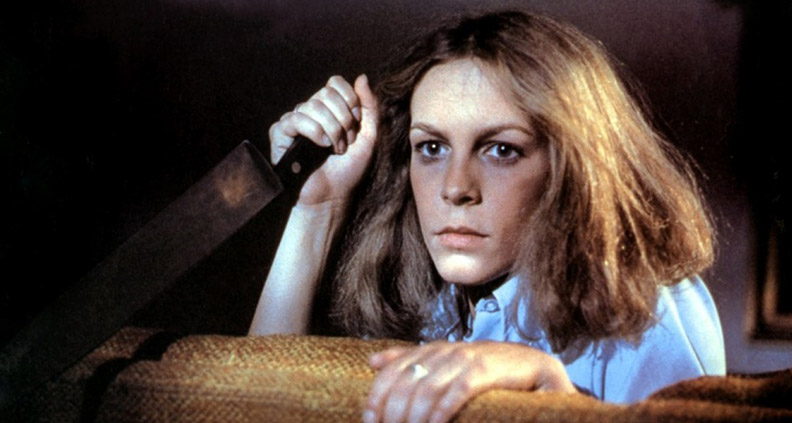It’s that time of year, when horror fans unite for a month of celebratory screenings of their favorite horror movies. And what more aptly named film to celebrate this month than the 1978 John Carpenter-directed, Debra Hill-produced classic Halloween, which many credit with inventing the whole slasher-film subgenre. As you undoubtedly know, the film follows the rampage of iconic masked slayer Michael Myers, who as a child first murders his sister and is then committed to an asylum for the criminally insane, only to escape years later and return home to idyllic Haddonfield, IL to resume killing.
Why you (probably) don’t think it’s an indie movie.
Admittedly, many outstanding horror films are indies. It’s not a reach to assume that any of your favorite spooky classics were probably made by a struggling auteur with a low budget and a handful of talented friends in a dark basement. However, Halloween makes a pretty convincing argument that it emerged ready to play in the big leagues. Aside from being one of the first, Halloween is also one of the most famous slasher movies of all time. Even if you’re not a fan of the genre, you’ve likely watched—or at the very least heard of—the Halloween franchise. Carpenter’s 1978 original led to a series of spin-offs and sequels, as many successful blockbusters do. The film drew inspiration from (and can be considered a successor to) legendary films such as Psycho and The Exorcist. Even the film’s “Laurie Strode house” shooting location is considered a civic landmark, due to its cinematic history (plus its ripe old age of 128—the house was built in 1888). Fans are often known to visit the Strode house’s new Pasadena address, where it was moved after almost being demolished, considered too important and therefore transplanted. How many horror movie locations are valued that highly? Secondly: the cast and the mask. Household name Jamie Lee Curtis (who has good horror in her blood—her mother Janet Leigh top-lined Psycho) starred alongside well-respected and established British thespian Donald Pleasence. Curtis tried for the role because she was a fan of Carpenter’s, who had actually turned her down for roles in the past. And who could forget the iconic, eerie white mask worn by Myers—a true classic amid mad-murder disguises, and nearly as famous as an image in its own right, apart from the film. Not to mention all of this fame has the numbers to back it up. The film grossed $47 million at the box office, which if you consider inflation would make it one of the most successful independent productions of all time.
Why it is an indie.
Despite the fame and fiscal success, it may not come as a surprise that Halloween is a total, bona fide indie. Let’s talk budget. The film was made for a very measly $320,000 and was shot over the course of 20 very rushed days during springtime, 1978. Somehow, the film was released that same October. Fall leaves were reused to save money, but the production couldn’t afford to make the actual trees look like fall (that’s why they’re so green and vibrant in the film). Although the film is set in Illinois, because it had to be filmed in Los Angeles you can even spot a few rogue palm trees. The pace of this kind of production and post-production is pretty unreal, but Carpenter made it possible by doing things like creating the entire score by himself in three days. The cast and the mask? Both lucky flukes. At the time, Carpenter didn’t even want to cast Jamie Lee Curtis, as she was essentially an unknown. She had to purchase her own costumes (reportedly all from J.C. Penney) for less than $100. Luckily for both, Halloween served as the actor’s breakout role, leading to a series of film and TV shows in- and out- of the horror genre. After being turned down by multiple other actors, Donald Pleasence eventually took the role of fear-mongering psychotherapist “Dr. Loomis” only because his daughter was a fan of Carpenter’s other work. Tommy Lee Wallace, who was the production director, art designer, location scout and co-editor (not uncommon for indie filmmakers to wear several hats) created the mask after Don Post Studios, a famous mask-making company, rejected the film’s business. He bought a Captain Kirk mask for just under $2, stretched it out and spray-painted it a ghostly white. Even the location screams indie. The now-historic Strode house was an actual abandoned house, which looked just as terrible in real life as it does in the film. The only time it was altered was for the early scenes, where the crew set up everything from plumbing and electricity to wallpaper, just to take it all out again after the shoot.
Halloween embraced its obstacles, kept an open mind and did the best it could with what it had—the earnest, blood-sweat-and-tears filmmaking carried out with beautiful unpredictability. You never know what could happen: how your film could fare at financially, how it could make its mark historically, how it could influence the culture, or, simply, whom it could really, really scare. NOTE: a version of this blog originally ran in 2016, authored by Film Independent blogger Kaia Placa. It appears in a revised version here. Special thanks to Kaia. Film Independent promotes unique independent voices by helping filmmakers create and advance new work. To become a Member of Film Independent, just click here. To support us with a donation, click here.
More Film Independent…
YouTube Twitter Facebook Instagram Events Upcoming Events Newsletter

